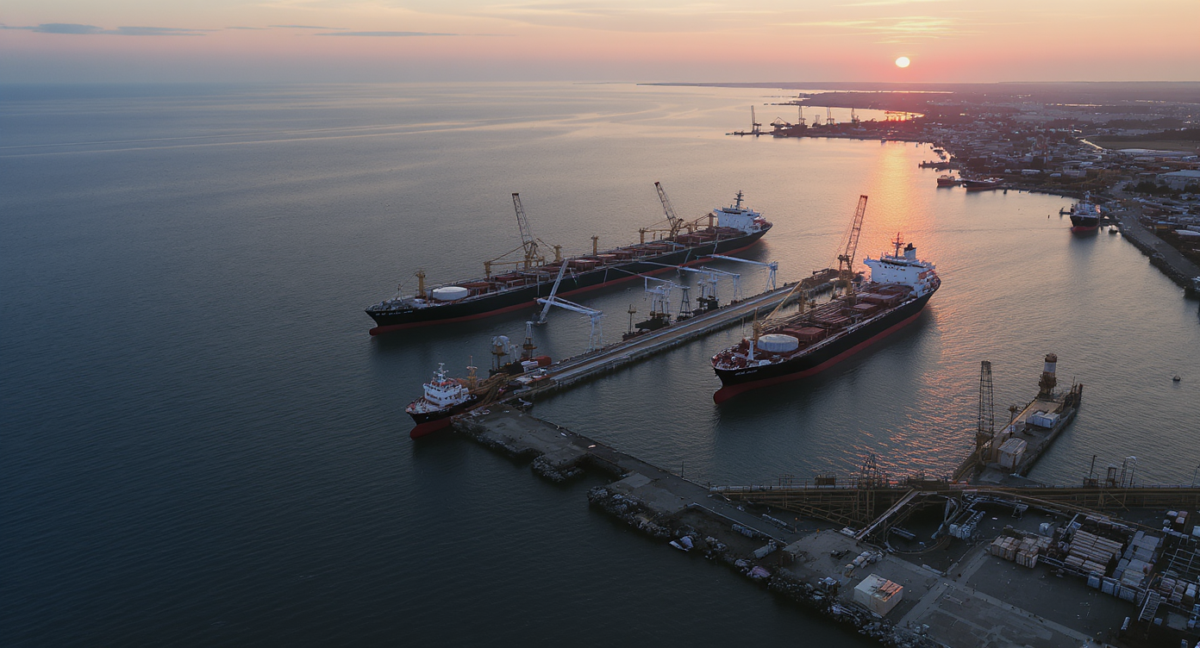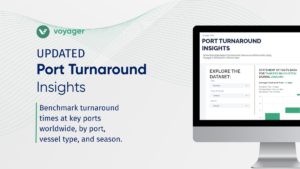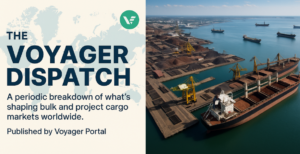It’s been a volatile year for global trade. New tariffs have surged, trade corridors are shifting, and customs bottlenecks once thought manageable are now core operational risks. But perhaps the most overlooked consequence for charterers lies in the difference between what’s happening on the ground and what’s written in the charter party agreement.
Trade Doesn’t Flow Like It Used To
In McKinsey’s latest scenario modeling, more than 30 percent of global trade could shift corridors by 2035, depending on how fragmentation unfolds, with flows between advanced economies and China among the most exposed. For charterers, this isn’t a distant macro forecast, and the shift is already underway.
Consider a chemical cargo traditionally routed via Shanghai–Rotterdam. A new tariff regime pushes the seller to export instead via Klang or Jebel Ali. What was once a direct 28-day voyage becomes a 36-day journey with an intermediary hub and a different customs environment. If the contract locks in routing, port pairs, or narrow arrival windows, this shift turns operational necessity into contractual breach.
Not every contract is built to handle this kind of operational pressure; and when it’s not, the risk of delay claims, demurrage disputes, or even mid-voyage renegotiations becomes very real.
The Hidden Cost of Misclassification
Beyond corridor shifts, customs complexity is creating a second pressure point: product classification. According to McKinsey, minor discrepancies in Harmonized Tariff Schedule (HTS) codes can significantly alter the duties owed, and by extension, determine whether a cargo clears port or sits idle.
That idle time, of course, isn’t free.
Charterers operating under voyage charters (particularly those responsible for laytime) are increasingly exposed when cargo is detained due to documentation errors or classification disputes. Yet in many cases, these risks sit outside the traditional boundary of operational control. The delay may originate upstream, with a supplier or freight forwarder. But the demurrage meter doesn’t care who caused it.
Unless the charter party explicitly addresses these scenarios through exception clauses, force majeure provisions, or adjustable laytime structures, the cost lands in the charterer’s lap.
Clause Awareness as Risk Management
Beyond corridor shifts, customs complexity is creating a second pressure point: product classification. According to McKinsey, minor discrepancies in Harmonized Tariff Schedule (HTS) codes can significantly alter the duties owed, and by extension, determine whether a cargo clears port or sits idle.
That idle time, of course, isn’t free.
Charterers operating under voyage charters (particularly those responsible for laytime) are increasingly exposed when cargo is detained due to documentation errors or classification disputes. Yet in many cases, these risks sit outside the traditional boundary of operational control. The delay may originate upstream, with a supplier or freight forwarder. But the demurrage meter doesn’t care who caused it.
Unless the charter party explicitly addresses these scenarios through exception clauses, force majeure provisions, or adjustable laytime structures, the cost lands in the charterer’s lap.
How Contract Clauses Impact Demurrage
For most charterers, demurrage is treated as a cost to manage, not a clause to question. But in a trade environment where routing is unstable and documentation delays are increasingly common, the fine print of the charter party becomes a primary driver of operational risk.
Some clauses that once felt boilerplate now act as blind spots: quietly transferring delay liability back onto the charterer. These risks don’t just live in legal departments; they show up in port every day.
Here are five clauses that regularly surface in disputes, especially when trade conditions shift faster than contracts do:
1. Laytime Commencement Clause
When does the clock start (and what conditions must be met)?
Some clauses make Notice of Readiness (NOR) contingent on free pratique or customs clearance, delaying the start of laytime until formalities are complete. Others, cut the other way: they allow NOR to be valid even without clearance, which means laytime and demurrage can begin to run while the vessel is still waiting at anchorage. In both situations, charterers face risk: either losing days before time counts or paying demurrage earlier than expected.
- Example – GENCON 2022, Clause 9(b):
“…the Vessel shall be entitled to tender Notice of Readiness from any waiting place … whether in free pratique or not, whether customs cleared or not. Laytime and time on demurrage shall then count…”
Read GENCON 2022 Charterparty (PDF)
Hidden impact: Data across several fixtures may show that whenever NOR hinged on clearance (or, conversely, was valid without it), charterers lost one or two days of laytime they thought they controlled. What looks like a “standard clause” may in fact be quietly inflating demurrage bills voyage after voyage.
2. Demurrage Exceptions Clause
What counts as a valid reason to stop the clock?
Most charterparties contain exceptions for events such as bad weather or strikes, but those carve-outs usually apply only during laytime. Once a vessel is on demurrage, the general rule is that “the clock never stops” unless the contract explicitly says otherwise. That means newer realities (such as inspections, customs delays, or tariff-related holds) will still accrue demurrage unless they are specifically written into the clause.
- Example – West P&I Club Guide:
“An exceptions clause will normally only apply to laytime. It will not protect the charterer after the vessel has come on demurrage, unless it explicitly provides so…”
Read the guide (West P&I PDF) - Example – ASBATANKVOY, Clause 6:
“…where delay is caused to the vessel getting into berth after giving notice of readiness for any reason over which Charterer has no control, such delay shall not count as used laytime.”
Read the contract (ASBATANKVOY PDF)
Hidden impact: Data analysis may reveal that once a vessel is on demurrage, the clock rarely stops. Charterers who assumed exceptions covered them may discover (too late) that the standard clause does not.
3. Port Rotation / Routing Clause
Are the discharge ports fixed or flexible?
In fragmented trade scenarios, the agreed route may no longer be commercially viable, yet many charterparties still restrict discharge to the ports nominated at fixture, even when conditions make them impractical. Without built-in flexibility or diversion provisions, even necessary detours trigger exposure.
- GENCON 1994, Clause 16(b) – Strikes at Port of Discharge:
“…the Charterers shall have the option of keeping the Vessel waiting until such strike or lock-out is at an end against paying half demurrage … or of ordering the Vessel to a safe port where she can safely discharge… On delivery of the cargo at such port … the Vessel shall receive the same freight as if she had discharged at the original port … except that if the distance to the substituted port exceeds 100 nautical miles, the freight … shall be increased in proportion.”
Read GENCON 1994 Charterparty (PDF) - GENCON 1994, Clause 18 – Ice at Port of Discharge:
“…Should ice prevent the Vessel from reaching port of discharge, the Charterers shall have the option of keeping the Vessel waiting until the re-opening of navigation and paying demurrage, or of ordering the Vessel to a safe and immediately accessible port where she can safely discharge without risk of detention by ice.”
Read GENCON 1994 Charterparty (PDF)
Hidden impact: Data across fixtures may reveal that whenever substitution was required, whether due to strikes, ice, or similar disruptions, charterers consistently paid more in freight or demurrage. Yet clauses like these are still carried forward as “standard,” limiting flexibility and amplifying costs just when charterers most need room to manoeuvre.
4. Time Bar for Claims Clause
How long do you have to contest a demurrage claim?
Some charterparties impose tight deadlines, known as “time bars”, giving charterers only 30 to 60 days to present or contest demurrage calculations. These provisions are among the harshest traps in the contract: miss the deadline and liability stands, even if the claim is wrong. In some widely used forms, the limit is fixed at 60 days, meaning that even a single day’s delay (or the omission of one required document) can void an otherwise valid dispute.
- Fortior Law (2023) – Example Demurrage Time-Bar Clause:
“Any demurrage claimed under this Charter Party has to be received by Charterers in writing with all supporting documents not later than 60 (sixty) days after completion of discharge… Any demurrage claim received later than 60 (sixty) days is to be considered null and void, and it shall be deemed that Owners have waived all their rights in respect of such demurrage claim.”
Read the full article (Fortior Law)
Hidden impact: Reviewing structured timestamps across voyages may show that valid disputes are consistently lost; not because the delays aren’t real, but because the claims aren’t lodged in time. Without digital tracking, these “silent losses” may remain invisible.
5. Force Majeure Clause
Does it actually cover what you think it covers?
Force majeure is often treated as a catch-all safety net, but not all clauses are created equal. Older forms tended to list only “war, strike, or Act of God,” leaving modern disruptions (sanctions, tariff enforcement, pandemic shutdowns) outside the scope. Even in updated wordings, force majeure usually protects both parties from being in breach, but it rarely interrupts the running of laytime or demurrage. When contracts don’t evolve with geopolitics, neither does your protection.
- BIMCO Force Majeure Clause 2022:
“Neither party shall be considered in breach of contract nor liable in damages for delay in or for non-performance of their obligations under this Charter Party, if such delay or non-performance is due to an event of Force Majeure… Where performance is rendered impossible, illegal or radically different … and the duration of the Force Majeure exceeds [x] days, either party may terminate this Charter Party.”
Read the full BIMCO Force Majeure Clause 2022
Hidden impact: Data may reveal that even when ports shut down under pandemic protocols or when sanctions froze payments, demurrage still accrued. The clause did its job in excusing owners and charterers from breach, but it rarely stopped the financial meter. Without visibility across fixtures, charterers may underestimate how often this supposed “safety net” fails them in practice.
Clause Intelligence as a Strategic Asset
Clause risks only become visible when charterers can see them across time. A clause that seemed harmless in a single fixture may, when viewed across a year of contracts and claims, emerge as a recurring source of loss. With structured data, those blind spots turn into leverage, giving charterers financial protection, legal footing, and operational flexibility in a market where routes, regulations, and risks keep shifting. This kind of intelligence can’t be built by scanning PDFs after the fact. It requires a system that makes contracts and claims data intelligible, actionable, and ready for the next negotiation.
The Case for Operational Clause Intelligence
Some charterers are starting to adapt, incorporating more flexibility into their contracts through broader laycan windows, alternate discharge options, or port performance clauses. Others are using timestamped voyage data to revisit terms that haven’t held up under real-world conditions.
But many are still in the early stages of making these shifts.
Recent months have highlighted that risk isn’t just about freight rates — it’s also in the operational assumptions embedded in contracts, which are becoming harder to rely on.
Before You Go…
Secure your seat at the Demurrage Innovation Forum | Singapore, 2025.
Join charterers, producers, and legal experts this November as we explore how AI and digitalisation are reshaping operations.
CHECK OUT OUR NEW TOOL!
Explore our updated Port Turnaround Insights—a free tool to benchmark time in port by vessel type, cargo, and season. It’s just a snapshot of the data our clients use to improve planning and reduce demurrage exposure.
Follow The Voyager Dispatch on LinkedIn
Our weekly newsletter tracks global dynamics shaping chartering, demurrage, and freight. Want updates delivered straight to your feed? Follow us on LinkedIn to never miss a Dispatch.




